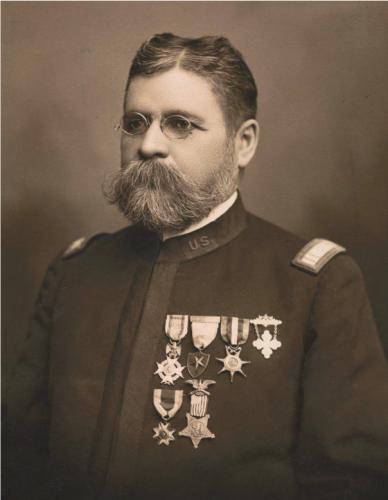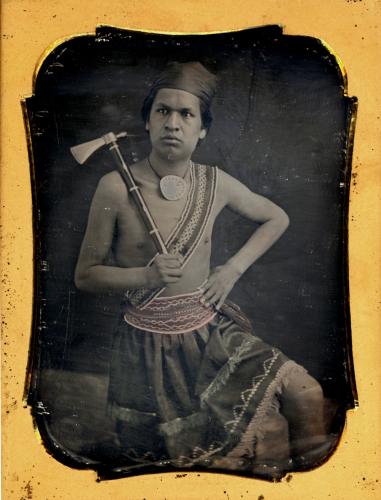Veterans call it “Army Logic.” Wartime deployments sometimes produce unintended, but deeply meaningful, ironies. One leading example in the distinguished history of American Indian military service was the career of the Tuscarora Company in the American Civil War. Raised from Iroquois volunteers in New York State, this unit found itself stationed in the homeland of its namesake, the territories in North Carolina from which the Tuscarora people had been expelled 140 years earlier. Furthermore, it played a major role in defending its post against an attack led by top generals of the Confederacy, in fighting the War Department described as “heroic.” This is their story.
The Tuscarora Company in the Tuscabora Homeland
During the Civil War, “D” Company of the 132nd New York State Volunteer Infantry was one of the more important Union military units composed of American Indian soldiers. D Company included 25 Haudenosaunee from the Allegany, Cattaraugus, Onondaga, Tonawanda and Tuscarora Reservations. Besides these Six Nations volunteers, many soldiers in Company D were naturalized citizens of German birth recruited at Buffalo, Brooklyn, Lewiston, Manhattan and Syracuse. Despite the overwhelming presence of these German Americans, this Union force was known as the “Tuscarora Company” since its leader was Lieutenant Cornelius C. Cusick, a Tuscarora.
The letters of its company’s third sergeant and color bearer, (Isaac) Newton Parker, have survived and are now housed in the library at the Buffalo History Museum. Newton was the younger brother of the more prominent Ely S. Parker, Tonawanda Seneca sachem and the first American Indian to serve as United States Commissioner of Indian Affairs. The letters tell a story of heroism, but they also reveal a bizarre side of “army logic.” Much of the unit’s involvement in combat under the banner of the United States ironically occurred in the same territory of North Carolina from which the Tuscaroras, the Haudenosaunee’s sixth nation, had been driven out in a war of extermination nearly a century and a half earlier!
In the first 11 months of the Civil War, the Haudenosaunee were repeatedly rejected for military service by the New York State Adjutant General. Recruiters turned away members of the Six Nations because of overt racism and because at that time almost all Indians were not United States citizens and there were no laws on the books specifying the legality of Indian military service. Although Natives were allowed immediate entry in other areas of the North such as Pennsylvania, they were time-and-time again rejected in western New York State.
This policy changed as a result of wartime exigencies to raise additional troops to fill quotas after Union casualties mounted and because of persistent lobbying by Haudenosaunee and their non-Indian allies. Lieutenant Cusick, soon to be the Tuscarora Company commander, and Cayuga Chief Peter Wilson were prominent in persuading the New York State Adjutant General’s Office to lift the ban. Local New York recruiting officers were finally allowed to accept Haudenosaunee enlistments in the spring of 1862.
Most Haudenosaunee volunteers in Company D served as ordinary volunteers and received the same pay as their white counterparts. One Haudenosaunee served as corporal, two as sergeants and one as lieutenant in Company D. Parker’s writings and letters of his white comrades in the 132nd New York State Volunteer Infantry reveal that mutual admiration existed and male bonding occurred between Indian and non-Indian soldiers. These Haudenosaunee soldiers were cited for meritorious service on several occasions in the United States Department of War’s Official Record of the War of Rebellion. Although there was prejudice in initially denying Indian recruitment in western New York, little, if any, evidence of racial prejudice in D Company is reflected in Parker’s letters.
Cusick, a Tuscarora sachem, did much of the recruitment in Six Nations communities. Cusick was born on the Tuscarora Indian Reservation in western New York on Aug. 2, 1835. His was among the most prominent families in Tuscarora history. Cusick’s grandfather was Nicholas Kaghnatsho [Cusick], the interpreter for General Marquis de Lafayette, during the American Revolution. According to the autobiography of Clinton Rickard, the eminent Tuscarora chief who founded the Indian Defense League of America in 1926, Cusick was his grandfather’s half brother. (Rickard himself had served with distinction in the Philippine Insurrection following the Spanish American War and was one of 10 soldiers assigned to protect Theodore Roosevelt, then Vice President of the United States, on his visit to Buffalo in 1901.)
Although there were accusations that Cusick as well as Parker profited from recruiting Six Nations soldiers, no evidence of these charges has been substantiated. Later, after the Civil War, Cusick served with distinction as a captain in the regular army on the Trans-Mississippi frontier until his retirement in 1891. Subsequently, he was appointed as honorary and special assistant in the Department of American Archaeology and Ethnology at the Columbian Exposition in Chicago.
The Haudenosaunee troops were transferred into the 132nd New York State Volunteer Infantry when the 53rd New York State Volunteer Infantry, a fancy-dressed Zouave regiment, was disbanded in the summer of 1862. After receiving assurances of getting a $25 bounty, a $2 premium and a month’s pay of $13 for enlisting, the 25 Iroquois were sent to Camp Scrogg in New York City. There they trained on the parade grounds and received regimental inspection. On Sept. 28, 1862, the regiment was sent to Washington, D.C., and temporarily encamped adjacent to the Capitol. A week later, the Haudenosaunee were mustered into service for three years and sent to Suffolk, Va., for reconnoitering, constructing works of defense and outpost duty at Camp Hoffman in Fort Monroe. They were under the command of General John Peck of Syracuse, N.Y.
The Battle of New Bern
On Christmas Eve, 1862, the unit was transferred to New Bern, N.C., which had been captured by Union General Ambrose Burnside in March. They were now assigned to guard the Union railways and prevent the Confederacy from re-supplying its forces by sea.
In early January 1864, General Robert E. Lee recommended that Confederate President Jefferson Davis order an attack on New Bern in order to capture the large amounts of Union army provisions stored there. Lee was also intent on recapturing the Union railroad at New Bern, which had been guarded by the Tuscarora Company and other Union forces. The Confederate commanding general needed the rail-line to re-supply his beleaguered Army of Northern Virginia. However, Lee badly underestimated his enemy’s abilities and chose the wrong commander, General George E. Pickett, to lead the strike.
The result was the second Battle of New Bern. With 13,000 men and 14 navy cutters, General Pickett moved on New Bern on Jan. 30, 1864, dividing his troops into three columns. Confederate General Seth M. Barton and his men were to cross the Trent River near Trenton and proceed to the south side of the river to Brice’s Creek below New Bern. He was to take the forts along the Neuse and Trent rivers and then enter New Bern via the railroad bridge, thus preventing Union reinforcement by land or water. Colonels James Dearing and John N. Whitford and their men were to move down the Neuse River and capture Fort Anderson.
According to historian John Barrett in his book, The Civil War in North Carolina, Generals Robert F. Hoke and Pickett and the remainder of the expeditionary force were to “move down between the Trent and the Neuse, endeavor to surprise the troops on Batchelor’s Creek, silence the guns in the star fort and batteries near the Neuse, and penetrate the town in that direction.” The Confederate navy was to descend the Neuse, capture Union gunboats and join up with the three Confederate columns.
According to Barrett, General Pickett “bungled the New Bern operations,” although he shifted blame to Generals Barton and Hoke. In his previous planning, Pickett had underestimated, as Lee did, the task at hand. Although General Hoke moved quickly to reach Batchelor’s Creek, the firing of pickets had warned the Union forces of the enemy’s approach. During the engagement, Union forces, composed of the 99th and 132nd New York State Volunteers and 12th New York State Cavalry, faced this considerable Confederate onslaught. Eleven Haudenosaunee were part of the Union picket post holding access to Batchelor’s Creek on the Neuse Road Bridge and at an old mill near the railroad. They defended the bridge until overcome by overwhelming Confederate numbers. According to the Official Record of the War of the Rebellion, the Union forces in Company D held their ground at the bridge until the Confederates brought up their artillery pieces. After delaying the enemy, they then blew up the bridge to prevent the Confederate advance.
Regimental commander Peter J. Claassen later cited the Haudenosaunee in the Tuscarora Company for heroism, a commendation repeated by Generals Butler and Peck. Claassen described the bravery of 11 Haudenosaunee in Company D, “who heroically held that all important point [at the bridge] for over one hour against thousands of the enemy.”
The Confederates stalled elsewhere. General Hoke failed to capture the Union railway line and thus could not make his entrance into the city. Instead, Hoke’s men adapted to the circumstances and cut down trees to help them ford Batchelor’s Creek. Two of Hoke’s regiments then crossed over the creek and routed the Union reinforcements. His men then marched to within a mile of New Bern waiting to join General Barton’s forces.
Barton’s men never reached Hoke. After passing through low swamp country with vast mud holes caused by winter showers, Barton came in view of the enemy’s breastworks close to Brice’s Creek at 8 a.m. on February 1. Instead of attacking immediately, which might have caught the Union forces by surprise, he ordered a reconnaissance while bringing up his artillery. The reconnaissance found that Union forces were more entrenched than previously thought. Historian Barrett has pointed out that Barton then reported to General Pickett that his troops were “unprepared to encounter so serious” and “insurmountable” a defense. In the meantime, Union forces were alerted and their artillery began to hit Barton’s position. Pickett then ordered Barton to join the troops before New Bern for an assault on that front. Yet to do so, Barton had to cross the Trent River and retrace his steps, which would have taken more than two days with his large force. When Pickett was informed that Barton and his men could not reach him until February 4, Pickett withdrew on February 3 and admitted failure. Although the Union forces suffered more than twice as many casualties – 100 compared to the Confederate 45 – the Confederates failed to capture the supplies they so desperately sought.
In the Official Record of the War of Rebellion, Capt. Charles G. Smith, the General Officer of the Day (February 10, 1864) of the 132nd New York State Volunteer Infantry, commended Cusick and several other commanders at Batchelor’s Creek for their “individual instances of coolness and heroism.” After lauding one “Lieutenant Haring” for his bravery in defending the Neuse bridge, Smith added: “In this he [Haring] was nobly seconded by Capt. Thomas B. Green, Lieutenant Cusick, and Companies D and G, with Lieutenants Gearing & Ryan, who were both badly wounded, the respective companies losing heavily.” Later, Capt. R. Emmett Fiske, also of the New York State Volunteer Infantry, wrote of the fight: “Lieutenant Cusick with some thirty of his warrior soldiers of his tribe, engaged the rebel advance in a sharp skirmish for several hours and by desperate fighting prevented the dislodgement of the picket reserves and the capture of the outpost camp.”
The bloody skirmish was later described by Newt Parker in shorthand fashion. The Seneca sergeant wrote about the swampy terrain, made a map of the battlefield, and mentioned the capture of Private William Kennedy, a Seneca Indian, who was sent off to Andersonville Prison where he later died. Indeed, the regiment paid a price for their heroism under fire. The 132nd New York State Volunteer Infantry lost five men, six others were wounded and 80 of its members were captured.
In June 1864, Colonel Claassen’s men were sent on a forced march – 73 miles in 39 hours – to the vicinity of Kinston, N.C. Cusick’s actions on reconnaissance at Jackson’s Mills were also lauded in the Official Record of the War of Rebellion. The official record noted that Cusick, “leading his Indians in a flank movement, distinguished himself by materially assisting in the capture of the commandant of Kinston, N.C. ... together with five of his officers and upwards of 50 of his rank & file.” They also captured 51 non-commissioned officers and privates and inflicted 30 to 40 casualties. Capt. Thomas B. Green, his officers and men were cited in the official record for the success of the operation, which was attributed to their “endurance and determination.” Claassen later wrote that at Jackson’s Mills, N.C., Cusick and his “dusky warriors” lying in wait in a “roadside thicket, with instructions to closely guard the rear,” completely trapped the rebels.
The Tuscarora Company’s last major encounter with Confederate forces occurred on March 7 to 10, 1865, at Wyse Forks, N.C. One of the casualties at the skirmish was Foster J. Hudson, 7th Sergeant of the company and a Seneca Indian from the Cattaraugus Reservation. The Seneca had been shot in the left knee joint. After falling with his wounds, Confederate soldiers robbed him of his watch. D Company re-captured him, and he was then sent to the military hospital at New Bern, since the bullet was lodged deep in the joint. Subsequently, military surgeons amputated his leg. Although there were hopes of recovery, Hudson died on March 23 of a hemorrhage, just 17 days before the end of the Civil War.
The Haudenosaunee in Company D had distinguished themselves in the Civil War and two of the 25 had made the ultimate sacrifice. Most were “grunts,” volunteers in a war that to most, if not all of them, was not about slavery or anti-slavery. Undoubtedly, their involvement was more for cultural reasons, family traditions of military service, economic survival and the hope that by enlisting, Washington and Albany officials would stop encroaching upon their lands and lives. Like many of their fathers and grandfathers, they once again joined in a war made by outsiders, this time by officials in Washington, D.C., and in Richmond, Va. Yet the irony remains, namely they had been led by a Tuscarora back to his people’s homeland to fight Carolineans who had expelled these Haudenosaunee a century and a half earlier.



